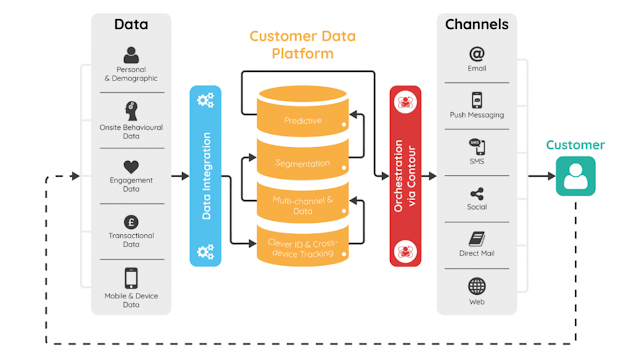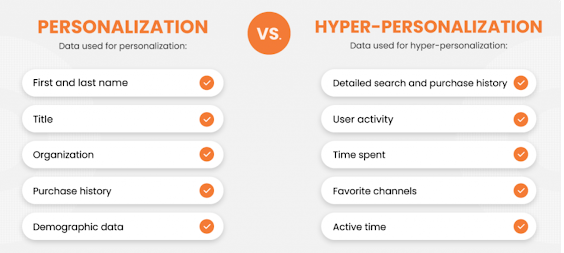Hyper-Personalization in Marketing: Using AI to Tailor Customer Experiences


In today’s competitive digital landscape, personalization has become a critical component of successful marketing strategies. However, as consumer expectations continue to rise, traditional personalization tactics are no longer sufficient. Enter hyper-personalization, a cutting-edge approach that leverages artificial intelligence (AI) and real-time data to create highly customized and relevant experiences for each individual consumer. In this blog, we’ll explore the concept of hyper-personalization, its benefits, and how brands can effectively implement it to enhance customer experiences.
What is Hyper-Personalization?
Hyper-personalization takes traditional personalization to the next level by using AI and big data to deliver more precise and individualized experiences. While personalization might involve addressing a customer by their name or recommending products based on past purchases, hyper-personalization analyzes vast amounts of real-time data to understand a customer’s behavior, preferences, and needs at a much deeper level. This allows brands to deliver highly targeted content, offers, and experiences that resonate on a personal level.

Key Components of Hyper-Personalization
- Artificial Intelligence and Machine Learning
- Predictive Analytics: AI algorithms analyze past behavior and predict future actions, allowing brands to anticipate customer needs and preferences.
- Real-Time Data Processing: Machine learning models process real-time data to adapt marketing messages and offers instantly, ensuring relevance and timeliness.
2. Big Data
- Comprehensive Data Collection: Hyper-personalization relies on collecting data from multiple sources, including online behavior, purchase history, social media interactions, and more.
- Data Integration: Integrating data from various channels provides a holistic view of the customer, enabling more accurate targeting and personalization.
3. Customer Segmentation
- Micro-Segmentation: Instead of broad segments, hyper-personalization focuses on micro-segments, allowing for more precise targeting based on specific behaviors and preferences.
- Dynamic Segmentation: Segments are continuously updated in real-time as new data is collected, ensuring that marketing efforts remain relevant and effective.

Benefits of Hyper-Personalization
- Enhanced Customer Experience
- Relevance: Customers receive content and offers that are highly relevant to their interests and needs, leading to a more engaging experience.
- Satisfaction: By addressing individual preferences and pain points, hyper-personalization increases customer satisfaction and loyalty.
2. Increased Conversion Rates
- Targeted Offers: Personalized recommendations and offers are more likely to convert, as they are tailored to the specific interests and needs of each customer.
- Reduced Cart Abandonment: Hyper-personalized reminders and incentives can help reduce cart abandonment rates by addressing the reasons behind it.
3. Improved ROI
- Efficient Marketing Spend: Hyper-personalization ensures that marketing resources are focused on the most promising leads and segments, maximizing the return on investment.
- Higher Engagement: Personalized content and offers lead to higher engagement rates, driving more conversions and sales.
Implementing Hyper-Personalization
- Invest in AI and Data Analytics
- Advanced Analytics Tools: Invest in AI-powered analytics tools that can process large volumes of data and provide actionable insights.
- Data Scientists and Analysts: Employ data scientists and analysts who can interpret data and develop effective personalization strategies.
2. Collect and Integrate Data
- Comprehensive Data Collection: Gather data from all available sources, including website interactions, email campaigns, social media, and offline channels.
- Unified Customer Profiles: Create unified customer profiles by integrating data from various touchpoints, ensuring a complete view of each customer.
3. Develop Personalized Content
- Dynamic Content Creation: Use AI to create dynamic content that can be tailored to individual preferences in real-time.
- Personalized Recommendations: Implement recommendation engines that provide personalized product suggestions based on customer behavior and preferences.
4. Test and Optimize
- A/B Testing: Continuously test different personalization strategies to identify what works best for your audience.
- Feedback Loops: Use customer feedback to refine and improve personalization efforts, ensuring that they remain relevant and effective.

My View on Hyper-Personalization
In my view, hyper-personalization represents the future of marketing. As consumers become increasingly discerning and demand more relevant experiences, brands that leverage AI and real-time data to deliver hyper-personalized content will have a significant competitive advantage. By investing in the right technology and strategies, businesses can not only enhance customer satisfaction and loyalty but also drive higher engagement and conversion rates. The era of one-size-fits-all marketing is over; it’s time to embrace the power of hyper-personalization.
Stay tuned for the next blog in our 80-day marketing series, where we’ll explore the transformative role of virtual reality in marketing.
Keep learning and stay curious!
